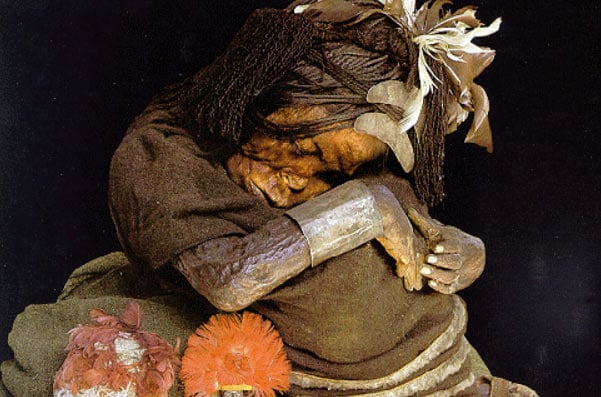Over a decade ago, the remains of three children were found, remarkably preserved, atop the summit of Volcan Llullaillaco in Argentina. In 2012, an analysis on the bodies of the 13-year-old ‘Maiden’ and her 4- to 5-year-old companions, Llullaillaco Boy and Lightening Girl, revealed that the children had been drugged and given alcohol on a regular basis as part of a year-long series of ceremonial processes leading up to their final sacrifice.

Archaeologists made the discovery after analysing hair samples from the frozen mummies, which revealed that all three children had consistently been given coca leaves (from which cocaine is derived) and beer. In addition, although they all appear to have had a peasant background as their diet consisted mainly of common vegetables, they all ate the food of the elite leading up to their death. This supports historical accounts suggesting that a few children were selected and prepared for their sacrifice as part of the sacred ceremonies.
Interestingly, evidence suggests that the Maiden was treated differently from the other two children, who may have even served as her attendants. For example, the 13-year-old consumed more of the elite food than the other two and was given the largest amount of coca and alcohol – while the younger children were given coca and alcohol for 9 months before their deaths, the Maiden was given the substances approximately 21 months beforehand.
Furthermore, the Maiden was found with a feathered headdress on her head, elaborately braided hair and a number of artefacts placed on a textile draped over her knees. By contrast, the Llullaillaco Boy had blood on his clothes, a nit infestation in his hair and a cloth binding his body, suggesting he may have died of suffocation. The Lightening Girl did not appear to have been treated as roughly but did not receive the same care or attention as the Maiden.

The Mummy of ‘Lightening Girl’
“The Maiden was perhaps a chosen woman selected to live apart from her former life, among the elite and under the care of the priestesses,” said Andrew Wilson, study lead and archaeologist at the University of Bradford in the U.K.

Evidence suggests the sacrificial ceremony may have been used as a form of social control. Being selected for the ritual was supposed to be seen as a great honour, but it probably produced a climate of fear. In fact, it was a major offense for parents to show any sadness after giving up their children for the ceremony. It is hoped that more work on the three mummies will reveal more about this society and its practice of ritual sacrifice.